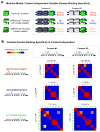A vast repertoire of Dscam binding specificities arises from modular interactions of variable Ig domains
- PMID: 17889655
- PMCID: PMC2707357
- DOI: 10.1016/j.cell.2007.08.026
A vast repertoire of Dscam binding specificities arises from modular interactions of variable Ig domains
Abstract
Dscam encodes a family of cell surface proteins required for establishing neural circuits in Drosophila. Alternative splicing of Drosophila Dscam can generate 19,008 distinct extracellular domains containing different combinations of three variable immunoglobulin domains. To test the binding properties of many Dscam isoforms, we developed a high-throughput ELISA-based binding assay. We provide evidence that 95% (>18,000) of Dscam isoforms exhibit striking isoform-specific homophilic binding. We demonstrate that each of the three variable domains binds to the same variable domain in an opposing isoform and identify the structural elements that mediate this self-binding of each domain. These studies demonstrate that self-binding domains can assemble in different combinations to generate an enormous family of homophilic binding proteins. We propose that this vast repertoire of Dscam recognition molecules is sufficient to provide each neuron with a unique identity and homotypic binding specificity, thereby allowing neuronal processes to distinguish between self and nonself.
Figures





References
-
- Baker MW, Macagno ER. In vivo imaging of growth cone and filopodial dynamics: evidence for contact-mediated retraction of filopodia leading to the tiling of sibling processes. J Comp Neurol. 2007;500:850–862. - PubMed
-
- Boggon TJ, Murray J, Chappuis-Flament S, Wong E, Gumbiner BM, Shapiro L. C-cadherin ectodomain structure and implications for cell adhesion mechanisms. Science. 2002;296:1308–1313. - PubMed
-
- Das R, Qian B, Raman S, Vernon R, Thompson J, Bradley P, Khare S, Tyka MD, Bhat D, Chivian DC, et al. Structure prediction for CASP7 targets using extensive all-atom refinement with Rosetta@home. Proteins: Structure, Function and Bioinformatics. 2007 in press. - PubMed
-
- Flanagan JG, Leder P. The kit ligand: a cell surface molecule altered in steel mutant fibroblasts. Cell. 1990;63:185–194. - PubMed
Publication types
MeSH terms
Substances
Grants and funding
LinkOut - more resources
Full Text Sources
Molecular Biology Databases

